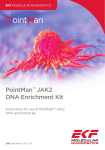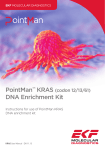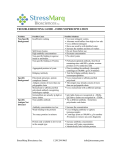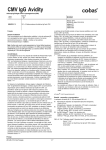Download Troubleshooting the Western blot procedure
Transcript
Analysis Procedures: Western blot Troubleshooting the Western blot procedure Problem: Chemiluminescent or chromogenic signal weak or not visible Possible cause Remedy Poor isolation of tagged protein Antibody too dilute Use a different cell lysis procedure Double the concentration of the Tag-specific Antibody (and/or the Secondary Antibody) Add more protein to gel. 1) Increase the electrical current and/or the transfer time for the blot. 2) Be sure there are no air bubbles between the membrane and gel during transfer. Too little protein on the gel Poor transfer of proteins from gel to membrane (Note: Check efficiency of transfer by silver staining the remaining gel. There should be minimal protein left in the gel.) Wrong type membrane Antibody incubation too short Signal development time too short Wash time too long or too stringent Enzyme on antibody conjugate inactivated by preservative (Note: To check enzyme activity, dot increasing dilutions of the antibody conjugate onto a membrane and perform the visualization reaction directly on the dilutions.) For maximum signal, use PVDF membranes for transfer. Incubate the Tag-specific Antibody (and/or the Secondary Antibody) with the membrane blot for a longer time. Double the development time. 1) Shorten the washing time. 2) Omit Tween 20 from the Wash Buffer. If you use POD-conjugated antibodies, do not use sodium azide in any Western blot reagent. If you use AP-conjugated antibodies, do not use a phosphate buffer in the washes following the incubation with Secondary Antibody; substitute a Tris buffer. Make fresh dilution of substrate or start with a different stock of substrate. Substrate inactive (Note: Check reagent on dot blot containing dilutions of antibody conjugate with established enzyme activity.) Epitope tag sequence is not detectable due to: • Proteolytic cleavage Include protease inhibitors in lysis buffer. • Low level of expression Use alternative expression system or optimize your expression system. Insert multiple tag sequences into target protein to increase avidity of antibody reaction. • Premature translation termination Use alternative insertion site within the target resulting in loss of C-terminal gene for the epitope tag sequence. tag sequence 3A 3.10 CONTENTS Analysis Procedures: Western blot Problem: High background, additional bands on blot Possible cause Remedy Antibody too concentrated Decrease concentration of Tag-specific Antibody (and/or Secondary Antibody) by half. Increase washing times. Leave blot membrane in substrate for a shorter time. For minimum background, use PVDF membranes for transfer. Use nonfat dry milk (5% w/v) dissolved in Reagent Diluent as Blocking Reagent. (Caution: High concentrations of nonfat dry milk may reduce specific signal as well as background.) 1) Use clean equipment, freshly prepared buffers, and new membranes. 2) Always avoid touching membranes with bare hands; use gloves and forceps. Use an F(ab')2 fragment of a secondary antibody, rather than an intact IgG. Use direct detection with peroxidase-conjugated monoclonal antibody to visualize tagged proteins. Reduce development time by half. Wash time too short Incubation of membrane with substrate too long Wrong type membrane Blocking Reagent too dilute Contaminated reagents or equipment Secondary antibody binds untagged proteins Heavy and light chains of primary antibody visible on blot membrane (Indirect detection procedures only) Signal development time too long 3A CONTENTS 3.11










